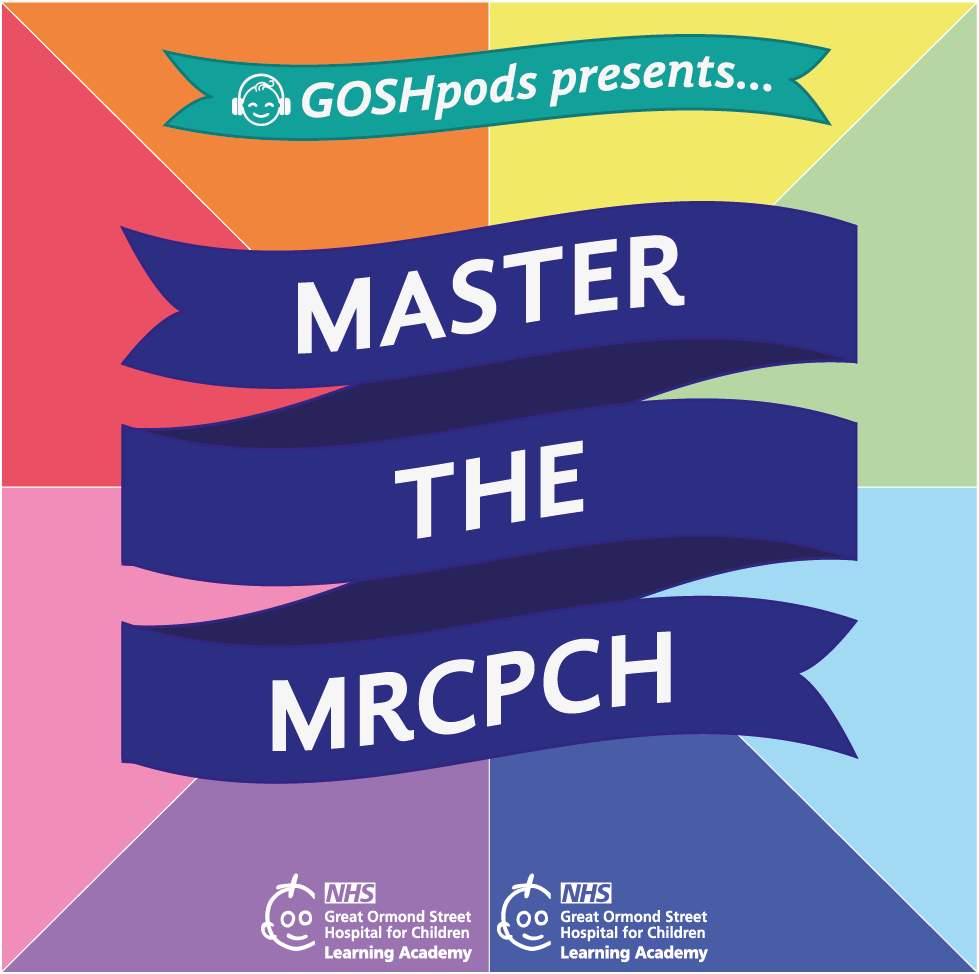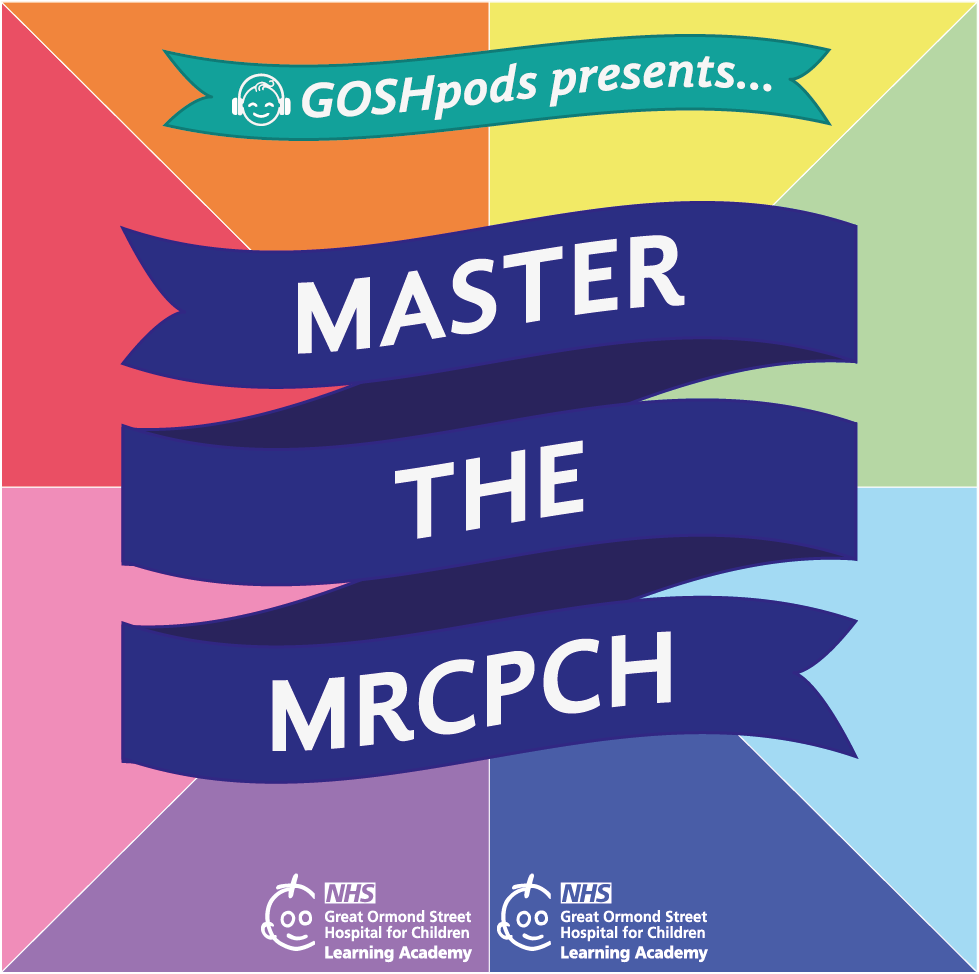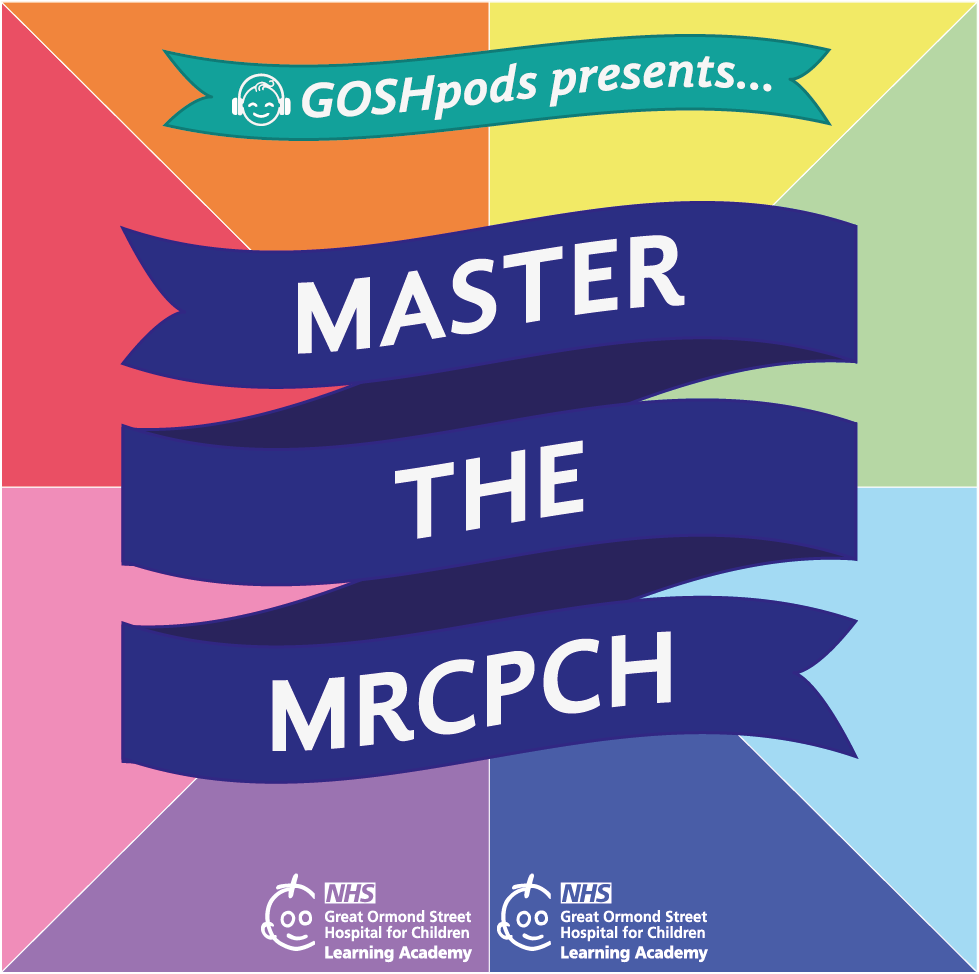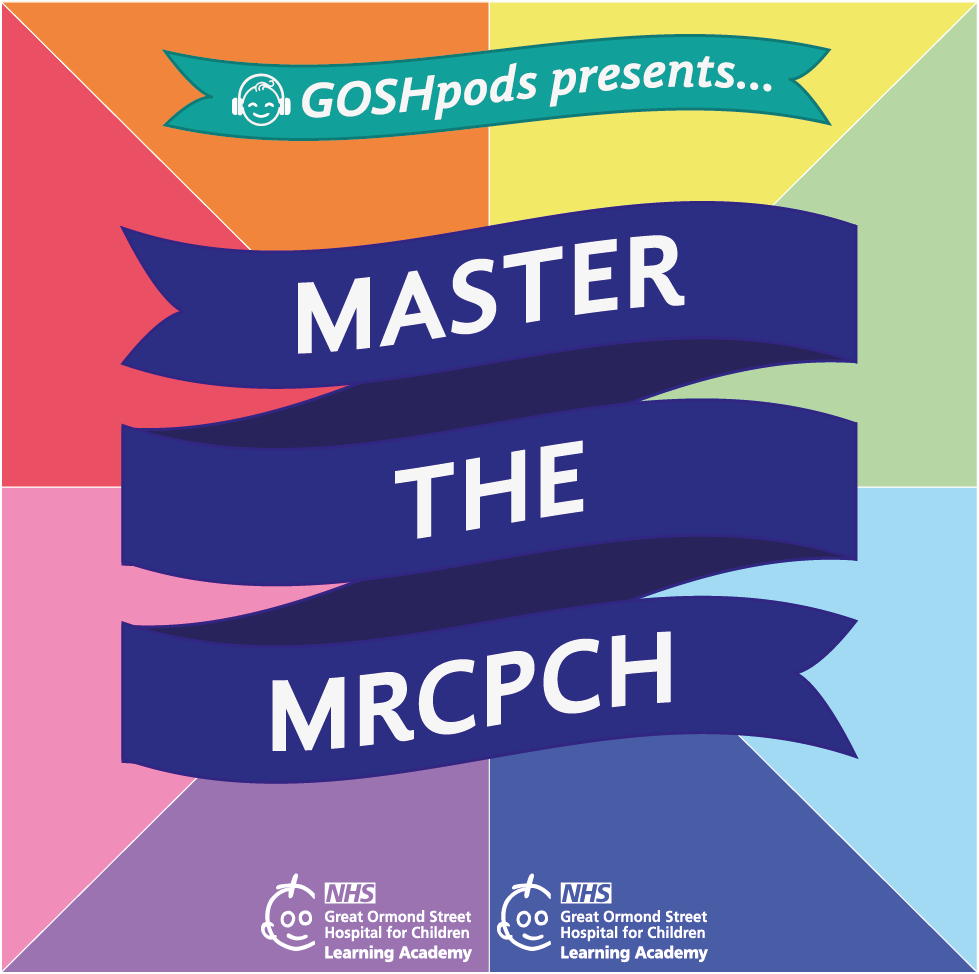This Podcast is brought to you by the GOSH Learning Academy.
SA: Hello, and welcome to Master the MRCPCH. In this series, we tap into the expertise here at Great Ormond Street Hospital to give you an overview of a topic on the RCPCH exam curriculum. So whether you're revising for an exam or just brushing up on a need to know topic. Hopefully this podcast can give you the information that you need.
I'm Dr. Sarah Ahmed, a paediatric registrar and the current digital learning education fellow here at GOSH.
In today's episode, we're going be talking with Dr Deborah Zeitlin about non-accidental injury and physical abuse. Dr. Zeitlin is a consultant general Paediatrician here at GOSH and is the name Doctor for Safeguarding for Children and Young People. Non-accidental injury comes under the safeguarding section of the MRCPCH curriculum. Child abuse is not an easy topic to talk about or listen to. Remember to look after yourselves. There are some resources in the episode description of places you can go to for help if you've been affected by anything that we've discussed.
SA: Deborah, thank you so much for coming back for part two of this episode on non accidental injury and physical abuse. Let's pick up where we last left off. I think we should go into a bit more detail about what you do if you have a suspicion of physical abuse including investigations. So let's say you have a child who's come into A&E. You suspect that they have had some form of physical abuse. What is the process that you should be going through?
DZ: So the first thing is to escalate it, and I'm going to say the following lots and lots and lots. This all about information sharing. Do not keep your concerns to yourself.
SA: Mm-Hmm
DZ: and the people to share it with are your team and your consultant and letting your consultant know that these are your concerns and why these are your concerns. And I would urge you all to be very objective. We have to look at the objective facts in front of us. In the very first instance, what I would urge you to do is to just take a minute to take a breath. And if you need to write it down, write down what exactly is concerning you. So you are really going to drill down. So a child comes in with bruising, let's say, and mom's gone outside to talk to her partner on the phone. And the, let's say it's a three year old's, been left in A&E by themselves. They're wearing dirty clothes, and they smell quite a bit. And you’re really concerned. They also look pale and thin, write down what the actual objective facts are. So it's going to be bruising. Where is the bruising? What does the bruising look like? As we said before, they're marks compatible with bruises. If that's what your opinion is. Where are they? How many of them are there? You want to write down the other concerning things. So child's wearing tatty clothes. What does that tell you? Is it that the family are really struggling financially and this is all the mum can do to provide, or is it that the mum is dressed beautifully and the child is wearing tatty ill-fitting clothes? This child is pale. Why does that concern you? Is it because it's a sign of being malnourished? Is it because it's a sign of being shut away from the environment, is it because they might have an underlying anaemia? Have a think about it, because it may be that you then say, well, actually this could be compatible with these other conditions. Or actually, I more strongly feel that these are red flags for abuse, physical abuse, neglect, emotion abuse, some, all of one of none of the above.
So once you've got that crystallised in your head, you want to raise the concern to your consultant as soon as possible. And then it's raising it to the right person. Your consultant may say that they will speak to the name doctor for safeguarding or ask you to do that. And I would urge you all to not to make decisions on your own. Safeguarding is a team effort. It is not a sole operator process.
And then we're going to need to take a history and it's a slightly different history and you can combine your clinical history with your safeguarding history. But really the important things from the safeguarding side, and I'm sure you're all incredibly proficient at taking clinical histories, but from the safeguarding side, if there's been a single incident that they've been brought in and you are concerned that this is not what it seems or that it is a concerning incident, an incident of trauma, then really what you want to do is go back through the history to the events leading up to the incident, to the episode of trauma. So let's say child comes in with two broken legs and dad says he fell off his bike, and you're like, hmm, this child's five years old. It's quite difficult to break both your legs on a bike. So you want to know a bit more. So I would go back at least twenty-four hours and get the parents to walk you through exactly what happened. And you want to note down the dates and the times of each event as it occurred from woke up, had breakfast, what did you have for breakfast? What happened? What did he dress in? Did you take him to school? Where did you go? What time did you go for the bike ride? Was it on flat ground? Was it on sloping ground? So you have to be a bit of a, a detective. Now our role is to gather information. It's not to interrogate, that's a police decision.
One of the reasons it's so important to get those details is that you might then want to compare other information those parents or carers have given for compatibility as to what was said initially. And for consistency. And it may be that you'll see a story changes, which would be a red flag, or it may be that extra details are given. And so that might give you an indication to then go a bit deeper into exactly what's happening at that point in the history.
So once you've got as much information as you can, there are a couple of steps that need to be followed. And I think that one of the things to consider are, is this child at immediate risk now? Are there other siblings or children at home who might be at risk? If there is a risk, we need to consider that and your consultant may advise that the police are involved. And certainly calling the local authority to flag your concerns. Outside of working hours, the local authority can still be contacted, and this will be through the EDT, or Emergency Duty Team, and they will be able to provide background information and advise, as would the local authority, during working hours. And so the EDT, the emergency duty team can be contacted at whatever the patient's local authority is. The information and concerns that you convey to the local authority, whether it's within hours or to the emergency out of hours team, will then be discussed and processed through something called the MASH, which stands for the Multi Agency Safeguarding Hub. And the key bits of information there are to provide the history, the clinical findings, the physical findings, your concerns, and your consultants, because two brains are better than one in these cases. And then the decision whether to proceed with safeguarding investigation is up to the local authority. If there's other children ask the local authority to make provisions whether they feel that it is safe for those children to still be with the parents. So your safeguarding responsibility doesn't just extend to the child in front of you. It's thinking about any children within that family who might be in a vulnerable situation.
So once you've got the local authority on board, they may refer to the police. The police may have already picked up on this and they may accompany a patient and parent in with you, or they may be called in A&E and it, they will work with you. They're the ones who can do a thorough interrogation.
And as I say, our jobs as health practitioners is to collect information and to present that evidence. The burden of proof – and I hopefully this reassures everybody because I know it's a huge concern. Everybody has the concern that they're either going to condemn parents who are innocent or send a child home who actually is being abused. But it is to make it very clear, our responsibility is the burden of presenting evidence. It is not the burden of proof. That's up to the courts, either the family courts and or the criminal courts. But the burden of presenting that evidence, collecting and presenting that evidence is so vital. We are only one slice of the pie. Don't forget. So paediatricians will be one slice. Radiology will be another slice depending on what the injury is. The schools, the GP, the health visitors, social services, the police all form up that, that that whole circle. But it's a really important part. And so I try to keep my language when I'm making notes, very simple in lay terms, so that as little as possible is misunderstood from what you've written. That times are very important. It's, I know it's when you're on a busy shift, it's really difficult. Try to record things contemporaneously, not after the fact. It creates much less problems when people are looking back and trying to put, put a chronology together. But also if it does go to court, then presenting that evidence you can be, you know, you can say this was contemporaneously recorded and it has a lot more forensic robustness. And that is the role that we play.
You may be asked to attend a local authority strategy meeting, which the police will be at. And that usually, if there are concerns will happen the next day if the child's been admitted, or even if they haven't. And at those meetings, if you've made good notes, then you have all the information there. And it's sharing that in a way that, you know, social workers, teachers, police can all understand it and they know what is fact and what is your opinion. And I say at junior doctor level, you shouldn't be going to those unsupported. You should be going to those accompanying a consultant.
In other cases where you've called up the local authority, whether it's in hours or out of hours, they may say they're okay for the child to go home with the parents, but they've arranged for a child protection medical to happen in the community. And so you may very often hear the term, oh, this met threshold for section forty-seven, which is a child protection plan investigation. Or it met threshold for a section 17, which is a child in need investigation and plan. So it's quite a common term that is used.
*trumpet sounds*
SA: Did you know that GOSH runs mock exams for the MRCPCH? Great Ormond Street has been running mock exams since June 2016. The mock is based on the MRCPCH clinical examination curriculum, and candidates are able to get the full experience and conditions of a real exam setting, and gain valuable feedback on their performance.
To find out more go to the GOSH website and search MRCPCH exams.
SA: We mentioned investigations a couple of times. We mentioned skeletal surveys and bloods. But can you just clarify for us what are the investigations that you should be doing? In cases like we've discussed?
DZ: So, really the, the easiest way to look at this is that I see it as a four part from beginning to end, from your input is a four part process. And so the first part is the interview and the history. And I'd call that an investigation. Because you are going in greater depth into the events and details and family set up.
The second part are the investigations, and there's a pretty standard set of investigations that we want to do. So if you are concerned about bruising or bleeding, it's the same, bruising is bleeding. Then we obviously want to do a coagulation screen. We'll have a look at the coagulation screen, and what I would then say is speak to your haematologist in your hospital if there's any abnormalities, or even if there's not and you are still concerned if it's odd pattern bruising and say is it worth doing an extended coagulation screen panel, because there are more than just the basic coagulation investigations such as complement, clotting factors and so on. That really should be guided by your haematologist.
You then want to do the same for bones. So you want to do a bone fragility screen, and that's going to be your bone profile. So your calcium, your phosphate, your vitamin D and a PTH as well. And if you are concerned about the results and you are not sure how to interpret them, don't struggle, call, speak to your consultant. And you may need to call somebody within your hospital who's a metabolic bone doctor or at specialist centre who's a metabolic bone doctor, and they will help you interpret. And whatever they say, ask them to document it in the notes if they can or if they're off site, you document what they've said in the notes as well.
So you then want to know, are these bones of normal strength metabolically or not? You are also going to look at the x-rays and the skeletal survey and, and if your radiologist hasn't commented on it, ask them to comment on the bone density.
As I said before, the other investigations are the skeletal survey parts one and part two, and if there's been a head injury, or the child is very young, under a year old, then you may want to do a CT head in the first instance because it's the quickest plus and minus an MRI brain scan as well.
And as part of that, if you suspect there's been a head injury or you see that there's something on a CT scan, then to get an ophthalmology assessment where they'll look for specifically retinal haemorrhages. And there's some very good information on retinal haemorrhages on the RCPCH Child Protection Portal.
In the last part of essential investigation would be a body map. You don't have to do a body map all at the same time. So if a child is stable enough for you to do the anterior of their body, let's say they're on intensive care, you can body map the front of their body and then when they're stable enough to be log rolled or turned over then you can do the posterior of the body. And you date the different days that you've done those. But then you've got at least part of it at the earliest possible time. Just remember that if there are dressings and bandages to ask the nurses who are looking after them or the teams who are looking after them, if they're changing those bandages, if it's clinically safe to do, to remove them, if it's not, when they're gonna change those, including endotracheal tapes around a mouth so that you can examine underneath it. So you've got as much of the body as is clinically safe for that patient to have examined is examined.
So you've got interview, you've got examination with the body map and the ophthalmology. You've got investigations, which are the blood tests we talked about. And then the fourth part really is your management plan, and that will include escalating to your consultant, name doctor discussions referring to the local authority if appropriate, contacting the police, and then what the safeguarding plan is.
It's important to say that in the investigations bit and the examination, I guess it bridges both, it's important to remember that you may also need other specialist investigations that are specific to that child's presentations or injuries. So it may be that you need to involve a, a dermatologist or you might need to involve an orthopaedic surgeon. You've still got to treat the clinical part, but also they may be able provide information in their opinion as to how they think the, what the mechanism of the injury might have been.
Just to finish off I mentioned right back at the beginning about the word likely. At some point, you'll be asked for your opinion on what it means, and everyone's always very apprehensive about this part, but if you are clear that this is the evidence and that this is your opinion on the evidence, they're two very separate things. And the phrase that I always use is on the balance of probability the evidence that we have gathered, or the findings from the investigations is that this is likely to be accidental or inflicted injury, aka non-accidental injury, or an underlying disease process. And so what you are saying is, I don't know for certain, I've actually only got a part of the information because it's only from the hospital admission. I don't have all of the other information that's out there about this child, their family, what the social setting is. And you are saying, I've looked at this evidence and I am drawing certain conclusions. I'm making you aware I'm drawing certain conclusions, but in my opinion, this would be my concern. And that's really the way to present it to people. And to phrase it. You know, you're not expected to be an authority. That is not what we're here for. It's to be able to provide specialist, 'cause as doctors, we are specialists, specialist insight into the history, the examination, and the investigations and the conclusions for what this child presented with.
SA: I think we should just round up with some quickfire questions. So firstly, are there any classic exam questions that could pop up about this subject?
DZ: Well, I think the really important thing here is just to keep at the back of your mind that safeguarding could be a differential diagnosis and to think why that might be. As we talked about before, pick out the salient points in the exam question and then you can see if it fits the pattern.
SA: Yeah, absolutely. I completely agree. Secondly, are there any useful resources that you would recommend?
DZ: Well, I'd say one of the most useful resources is the Child Protection Portal on the RCPCH website. There are various other ones such as the Working Together 2018 document, the summary of it, the Children's Act salient points from 1989. But a lot of it is summarized on the Child Protection Portal and certainly it's got some really good summaries of common presentations within child protection.
SA: Yeah. And I will make sure everything is linked in the description. And finally, what are your three takeaway learning points?
DZ: Safeguarding is everybody's responsibility. What just differs is what you are able to do within that remit of responsibility dependent on your role. A safeguarding investigation is just that, it is an investigation. You wouldn't say, I'm not going to investigate a clinical presentation because you're concerned about the outcome. So why think that with safeguarding, so it's an investigation. It may come out that is likely there's been no inflicted injury or neglect or any of the other categories of abuse. Or it may be that there is evidence to pointing towards it and that this child needs to be protected. Either way, the investigation is in the best interest of the child and family. It's not ascribing guilt or blame at this stage. It is purely an investigation. And I think the third thing, which I started off speaking about right back at the beginning is that information gathering and sharing is key and sharing it in a way that everybody can understand.
SA: This has been wonderful, Deborah. Thank you so much for a really comprehensive approach to non-accidental injury and physical abuse. Thank you.
DZ: Thank you very much for having me.
SA: Thank you for listening to this episode of Master the MRCPCH. We would love to get your feedback on the podcast and any ideas you may have for future episodes. You can find link to the feedback page in the episode description, or email us at
[email protected]. If you want to find out more about the work of the GOSH Learning Academy, you can find us on social media, on Twitter, Instagram, and LinkedIn. You can also visit our website at www.gosh.nhs.uk and search Learning Academy. We have lots of exciting new podcasts coming soon so make sure you're subscribed wherever you get your podcasts. We hope you enjoy this episode and we'll see you next time. Goodbye.



